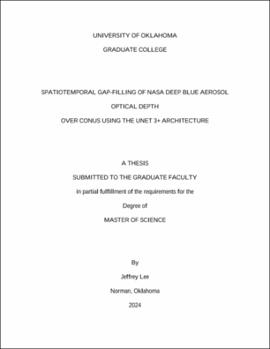| dc.description.abstract | Due to sensor and algorithmic constraints, satellite aerosol optical depth (AOD) retrievals are spatially incomplete over clouds, deserts, and other bright surfaces. These gaps in satellite AOD datasets represent a significant challenge in characterizing aerosol distributions at a daily temporal resolution. These challenges are essential to overcome due to aerosol impacts on human health, the economy, weather, and climate. The task of filling these gaps in AOD datasets is known as AOD gap-filling. In this study, we propose using a deep learning (DL) architecture called UNet 3+ to perform this task. The model is trained on Deep Blue (DB) AOD retrievals from Terra, Aqua, and S-NPP, MERRA-2 reanalysis AOD, meteorological and land-use variables from NAM, and HMS smoke polygons. Through spatial evaluations against AERONET and DB AOD, we show that such an approach is feasible over CONUS, even in the semi-arid western U.S. where historically, topography, bright surfaces, and snowpacks have made AOD gap-filling a challenging problem. We created spatiotemporal datasets of daily gap-filled DB AOD from 2012-2022 over CONUS at a 12 x 12 km2 resolution with statistical evaluations of RMSE~0.08 and r~0.84 against collocated AERONET retrievals. This dataset will be a starting point for future aerosol-related studies, such as acute daily PM¬2.5 (particulate matter with an aerodynamic diameter smaller than 2.5 µm) exposure studies. Some potential challenges exist with the suggested approaches and, more generally, in estimating AOD and PM¬2.5. The first is the sampling bias that naturally arises from AOD retrievals, whether from ground- or satellite-based sensors. As no retrievals are performed in cloudy pixels, any model trained on this data is only aware of the dynamics of clear-sky AOD, and we cannot directly validate estimations over cloudy-sky areas (not even with ground truth AERONET). However, because this research aims to use AOD to estimate PM¬2.5 and hydrological effects tend to lower aerosol concentrations (e.g., washout from precipitation), the methods can be justified as providing an upper-bound (acute) estimate for exposure. | en_US |

